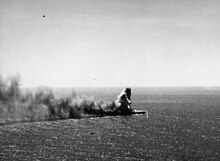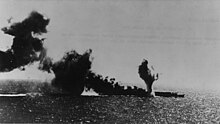Japanese aircraft carrier Shōhō
 Shōhō, 20 December 1941
| |
| History | |
|---|---|
| Name | Shōhō |
| Namesake | Japanese: 祥鳳, "Auspicious Phoenix', or "Happy Phoenix" |
| Builder | Yokosuka Naval Arsenal |
| Laid down | 3 December 1934 |
| Launched | 1 June 1935 |
| Commissioned | 30 November 1941 |
| Fate | Sunk by air attack during the Battle of the Coral Sea, 7 May 1942 |
| General characteristics (as converted) | |
| Class and type | Zuihō-class aircraft carrier |
| Displacement | 11,443 standard ) |
| Length | 205.5 m (674 ft 2 in) |
| Beam | 18.2 m (59 ft 8 in) |
| Draft | 6.6 m (21 ft 7 in) |
| Installed power |
|
| Propulsion | 2 × shafts; 2 × geared steam turbines |
| Speed | 28 knots (52 km/h; 32 mph) |
| Range | 7,800 nmi (14,400 km; 9,000 mi) at 18 knots (33 km/h; 21 mph) |
| Complement | 785 |
| Armament |
|
| Aircraft carried | 30 |
| Aviation facilities | 2 × Aircraft elevators |
Shōhō (
Design, construction and conversion

Shōhō and her

After her conversion, Shōhō had a length of 205.5 meters (674 ft 2 in)
Shōhō's flight deck was 180 meters (590 ft 6 in) long and had a maximum width of 23 meters (75 ft 6 in). The ship was designed with a single hangar 124 meters (406 ft 10 in) long and 18 meters (59 ft) wide.
The ship's primary armament consisted of eight 40-
Service history

Shōhō was commissioned on 30 November 1941 and
In late April 1942, Shōhō was assigned to Operation MO and arrived in Truk on 29 April. The following day, she departed Truk with the cruisers
Battle of the Coral Sea

After covering the landings on Tulagi on 3 May, Shōhō headed north to cover the invasion convoy the next day and was not present when aircraft from the American carrier Yorktown attacked Japanese shipping at Tulagi. This air strike confirmed that at least one American carrier was in the vicinity, but the Japanese had no idea of its location.[9] They launched a number of reconnaissance aircraft the following day to search for the Americans, but without result. One Kawanishi H6K "Mavis" flying boat spotted Yorktown, but was shot down by one of Yorktown's Grumman F4F Wildcat fighters before she could radio a report. US Army Air Forces (USAAF) aircraft spotted Shōhō[Note 1] southwest of Bougainville Island on 5 May, but she was too far north to be attacked by the American carriers, which were refueling.[11] That day, Rear Admiral Frank Jack Fletcher received Magic intelligence that placed the three Japanese carriers known to be involved in Operation MO near Bougainville, and predicted 10 May as the date of the invasion. It also predicted airstrikes by the Japanese carriers in support of the invasion several days before 10 May. Based on this information, Fletcher planned to complete refuelling his ships on 6 May and move closer to the eastern tip of New Guinea to be in a position to locate and attack Japanese forces on 7 May.[12]
Another H6K spotted the Americans during the morning of 6 May and successfully shadowed them until 14:00. The Japanese, however, were unwilling or unable to launch air strikes in poor weather or without updated spot reports.
American reconnaissance aircraft reported two Japanese heavy cruisers northeast of Misima Island in the Louisiade Archipelago off the eastern tip of New Guinea at 07:35 and two carriers at 08:15. An hour later, Fletcher ordered an airstrike launched, believing that the two carriers reported were Shōkaku and Zuikaku. Lexington and Yorktown launched a total of 53 Douglas SBD Dauntless dive bombers and 22 Douglas TBD Devastator torpedo planes escorted by 18 F4F Wildcats. The 0815 report turned out to be miscoded, as the pilot had intended to report two heavy cruisers, but USAAF aircraft had spotted Shōhō, her escorts and the invasion convoy in the meantime. As the latest spot report plotted only 30 nautical miles (56 km; 35 mi) away from the 0815 report, the aircraft en route were diverted to this new target.[16]

Shōhō and the rest of the Main Force were spotted by aircraft from Lexington at 10:40. At this time, Shōhō's
With Shōhō hit by no fewer than 13 bombs and 7 torpedoes, Captain Izawa ordered the ship abandoned at 11:31. She sank four minutes later. Some 300 men successfully abandoned the ship, but they had to wait to be rescued as Gotō ordered his remaining ships to head north at high speed to avoid any further airstrikes. Around 14:00, he ordered the destroyer Sazanami to return to the scene and rescue the survivors.[18] She found only 203, including Captain Izawa. The rest of her crew of 834 died during the attack or in the water awaiting rescue.[19] Shōhō was the first Japanese aircraft carrier lost during the war.[20]
Notes
Footnotes
- ^ Peattie, pp. 241–242
- ^ a b Jentschura, Jung and Mickel, p. 49
- ^ Jentschura, Jung and Mickel, p. 48
- ^ a b Peattie, p. 242
- ^ Brown, p. 22
- ^ a b c Tully
- ^ a b Lundstrom, p. 188
- ^ Stille, p. 32
- ^ Stille, pp. 46, 48
- ^ Lundstrom, p. 181
- ^ Stille, pp. 49, 51
- ^ Lundstrom, p. 179
- ^ Lundstrom, pp. 178, 181–182, 187
- ^ Stille, p. 52
- ^ Lundstrom, pp. 189–191
- ^ Lundstrom, pp. 193, 195–196
- ^ Lundstrom, pp. 198–206
- ^ Lundstrom, p. 205
- ^ Stille, p. 61
- ^ "Battle of the Coral Sea". The Aviation History On-Line Museum. Retrieved 10 January 2012.
References
- Brown, David (1977). WWII Fact Files: Aircraft Carriers. New York: Arco Publishing. ISBN 0-668-04164-1.
- Jentschura, Hansgeorg; Jung, Dieter; Mickel, Peter (1977). Warships of the Imperial Japanese Navy, 1869–1945. Annapolis, Maryland: United States Naval Institute. ISBN 0-87021-893-X.
- Lengerer, Hans (2023). The Aircraft Carriers of the Imperial Japanese Navy and Army: Technical and Operational History. Vol. II. Katowice, Poland: Model Hobby. ISBN 978-83-60041-71-0.
- Lundstrom, John B. (2005). The First Team: Pacific Naval Air Combat from Pearl Harbor to Midway. Annapolis, Maryland: Naval Institute Press. ISBN 1-59114-471-X.
- ISBN 1-55750-432-6.
- Stille, Mark (2009). The Coral Sea 1942: The First Carrier Battle. Campaign. Vol. 214. Oxford, UK: Osprey Publishing. ISBN 978-1-84908-106-1.
- Tully, Anthony P. (1999). "IJN Shoho: Tabular Record of Movement". Kido Butai. Combinedfleet.com. Retrieved 11 December 2011.
Further reading
- Japanese Army Operations in the South Pacific Area: New Britain and Papua Campaigns, 1942–43. Translated by Bullard, Steven. Canberra: Australian War Memorial. 2007. Senshi Sōshō)
- Polmar, Norman; ISBN 1-57488-663-0.
